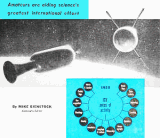Electronics & Technology
- See Full List of AI Topics -

International Geophysical Year First Day Cover
The
International Geophysical Year (IGY) was an extraordinary scientific endeavor,
representing a global cooperative effort to study Earth's physical properties and
atmosphere. Spanning from July 1, 1957, to December 31, 1958, the IGY was timed
to coincide with a period of maximum solar activity, a factor which was thought
to significantly influence Earth's environment. The project brought together scientists
from 67 countries, transcending Cold War tensions, with the goal of advancing our
understanding of the Earth and space sciences. This extensive treatise delves into
the various aspects of this monumental event, including the research conducted,
the countries involved, key figures, industrial partnerships, the science of rockets
and satellite launches, and the impact it had on both the military and civilian
sectors.
 The IGY's origins can be traced
to discussions initiated in the 1950s by a group of scientists who recognized that
an era of technological advancement had presented new opportunities for the study
of geophysics. The idea built on previous international cooperative scientific efforts
such as the International Polar Years of 1882-1883 and 1932-1933. However, the IGY
was much broader in scope, extending beyond the poles to encompass Earth's magnetosphere,
oceans, glaciers, and atmosphere. Importantly, this period also marked humanity's
first steps into space, as the IGY became a launching point for the
Space Race between
the United States and the Soviet Union. The IGY's origins can be traced
to discussions initiated in the 1950s by a group of scientists who recognized that
an era of technological advancement had presented new opportunities for the study
of geophysics. The idea built on previous international cooperative scientific efforts
such as the International Polar Years of 1882-1883 and 1932-1933. However, the IGY
was much broader in scope, extending beyond the poles to encompass Earth's magnetosphere,
oceans, glaciers, and atmosphere. Importantly, this period also marked humanity's
first steps into space, as the IGY became a launching point for the
Space Race between
the United States and the Soviet Union.
Among the leading countries participating in the IGY were the United States,
the Soviet Union, the United Kingdom, Japan, France, and Australia. Despite the
geopolitical tensions of the Cold War, cooperation was paramount, with researchers
sharing data across borders to support collective goals. This collaboration was
notable in the realm of space exploration, as the IGY provided the impetus for the
first artificial satellites, setting the stage for one of the most significant breakthroughs
in modern science: the dawn of the Space Age.
Key researchers and scientists were at the heart of the IGY's success. American
physicist James Van Allen was a central figure, instrumental in the study of cosmic
rays. Van Allen's work ultimately led to the discovery of the radiation belts that
bear his name, significantly contributing to our understanding of space weather.
Lloyd Berkner, another prominent American scientist, was a major advocate for the
IGY and played a pivotal role in organizing the event through the International
Council of Scientific Unions (ICSU). British physicist Sydney Chapman served as
president of the ICSU during the IGY, and his work on solar-terrestrial physics
shaped much of the research agenda. In the Soviet Union, Mstislav Keldysh was a
key scientific leader, contributing to the country's space program. Together, these
individuals, along with many others, formed the backbone of the IGY's scientific
research.
One of the most significant outcomes of the IGY was the launch of the first artificial
satellites. The Soviet Union was the first to achieve this milestone with the launch
of Sputnik 1 on October 4, 1957. This small satellite, weighing just 83.6 kilograms,
orbited Earth every 96 minutes and sent back beeps that could be picked up by radio
receivers around the globe. It marked the first man-made object to enter space,
capturing the world's attention and signaling the Soviet Union's scientific prowess.
The United States, meanwhile, responded with its own satellite, Explorer 1, which
launched on January 31, 1958. Built by the Jet Propulsion Laboratory (JPL) and powered
by a modified Redstone rocket booster, Explorer 1 was smaller than Sputnik, weighing
13.9 kilograms, but it carried scientific instruments that led to the discovery
of the Van Allen radiation belts.
The development of rocket boosters during the IGY was a complex process, heavily
influenced by military technology. The Soviet R-7 Semyorka rocket, which was originally
developed as an intercontinental ballistic missile (ICBM), was modified to launch
Sputnik 1. The R-7 was a two-stage rocket that measured 34 meters in length and
had a total weight of 280 metric tons. Its thrust was provided by four strap-on
liquid-fueled boosters, making it powerful enough to break through Earth's atmosphere
and place a satellite into orbit. In the United States, the Redstone missile, originally
developed by the Army Ballistic Missile Agency (ABMA), served as the foundation
for the Juno I launch vehicle, which propelled Explorer 1 into space. The Redstone's
engine, built by Rocketdyne, weighed 6.5 tons and produced 78,000 pounds of thrust.
Though smaller than its Soviet counterpart, it was a crucial first step for the
U.S. in its pursuit of space exploration.
Data collection during the IGY covered a wide range of scientific disciplines.
Research was conducted on solar activity, cosmic rays, Earth's magnetic field, the
ionosphere, ocean currents, and polar ice sheets. For instance, researchers studied
the Earth's magnetosphere by observing changes in cosmic ray intensity during geomagnetic
storms. Ground stations around the world collected atmospheric data, with particular
focus on regions like Antarctica and the Arctic. Glaciology teams studied the dynamics
of ice sheets in both polar regions, providing important data on global climate
patterns. Furthermore, the IGY helped develop techniques for deep-sea exploration,
as countries collaborated on oceanographic research, mapping undersea ridges, and
investigating seismic activity along fault lines.
Despite its many successes, the IGY also experienced challenges and failures.
The U.S.'s early satellite efforts encountered difficulties, particularly with the
Vanguard program, which aimed to launch a satellite into orbit as part of the IGY.
The Vanguard TV-3 rocket exploded on the launch pad on December 6, 1957, in a highly
publicized failure that highlighted the technical challenges of space exploration.
In contrast, the Soviet Union's success with Sputnik embarrassed the United States
and added urgency to the space race. However, these setbacks were part of the learning
process, and they spurred further advancements in rocket technology and project
management in both countries.
Launch facilities played a crucial role in the IGY, with significant resources
devoted to the development of infrastructure. In the United States, Cape Canaveral
in Florida became the hub for rocket launches, transitioning from military missile
tests to space exploration activities. The Soviet Union's Baikonur Cosmodrome, located
in Kazakhstan, was the launch site for Sputnik and later became the primary facility
for Soviet space missions. Both launch sites were initially military installations,
reflecting the dual-use nature of rocketry during this period. The same technology
that propelled satellites into orbit was derived from ballistic missile programs,
illustrating the close relationship between military and civilian applications of
rocket science.
The IGY's impact on both military and civilian sectors was profound. In the military
sphere, the success of Sputnik underscored the strategic importance of rocket technology,
prompting both the United States and the Soviet Union to accelerate their missile
programs. The U.S. established the Advanced Research Projects Agency (ARPA), which
would later become the Defense Advanced Research Projects Agency (DARPA), to develop
advanced missile and space technologies. At the same time, the IGY laid the groundwork
for the civilian space programs that followed. NASA, created in 1958, was a direct
response to the challenges posed by the Soviet space program and the IGY's revelations
about the potential for scientific exploration in space.
In the civilian realm, the IGY advanced public interest in science and sparked
a new era of space exploration. It demonstrated the value of international collaboration
in the scientific community, fostering a spirit of cooperation that persisted through
future scientific initiatives. Universities and research institutions around the
world benefited from the data collected during the IGY, leading to advancements
in fields as diverse as geophysics, meteorology, oceanography, and space science.
Companies specializing in aerospace, electronics, and engineering, such as Lockheed
Martin, General Electric, and Hughes Aircraft, played key roles in developing technology
used in satellites and rockets.
In conclusion, the International Geophysical Year was a watershed moment in the
history of science. It opened new frontiers in space exploration, advanced our understanding
of Earth's physical properties, and fostered unprecedented international cooperation.
Although marked by geopolitical tensions and technical challenges, the IGY's legacy
is one of scientific achievement and collaboration that laid the foundation for
the modern space era. Through the work of key researchers, the development of cutting-edge
technology, and the participation of countries across the globe, the IGY remains
a defining moment in the history of global science and a testament to the power
of collective inquiry.
 This content was generated by the ChatGPT
artificial intelligence (AI) engine. Some review was performed to help detect and
correct any inaccuracies; however, you are encouraged to verify the information
yourself if it will be used for critical applications. In some cases, multiple solicitations
to ChatGPT were used to assimilate final content. Images and external hyperlinks
have also been added occasionally. Courts have ruled that AI-generated content is
not subject to copyright restrictions, but since I modify them, everything here
is protected by RF Cafe copyright. Your use of this data implies an agreement to
hold totally harmless Kirt Blattenberger, RF Cafe, and any and all of its assigns.
Thank you. Here are the major categories. This content was generated by the ChatGPT
artificial intelligence (AI) engine. Some review was performed to help detect and
correct any inaccuracies; however, you are encouraged to verify the information
yourself if it will be used for critical applications. In some cases, multiple solicitations
to ChatGPT were used to assimilate final content. Images and external hyperlinks
have also been added occasionally. Courts have ruled that AI-generated content is
not subject to copyright restrictions, but since I modify them, everything here
is protected by RF Cafe copyright. Your use of this data implies an agreement to
hold totally harmless Kirt Blattenberger, RF Cafe, and any and all of its assigns.
Thank you. Here are the major categories.
Electronics & High Tech
Companies | Electronics &
Tech Publications | Electronics &
Tech Pioneers | Electronics &
Tech Principles |
Tech Standards
Groups & Industry Associations |
Societal Influences on Technology
|










